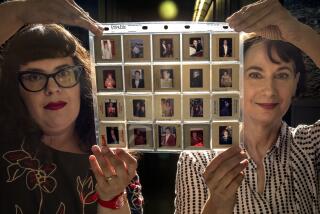Cold War bunker now shelters archive
- Share via
“Casablanca” and “Gone With the Wind” are finding refuge in a Cold War-era bunker near Virginia’s Shenandoah Valley.
The original negatives of those classic films are part of the world’s biggest audiovisual collection, held by the Library of Congress.
Their new home is a radiation-hardened building once used by the Federal Reserve to store cash and emergency supplies in the event of a nuclear attack.
Archivists are filling the facility with more than 6 million items -- films, audio recordings, television shows, posters, screenplays and musical scores -- gathered from storage sites across the United States. They’re on the lookout for treasures such as the recently unearthed 1957 Carnegie Hall concert by Thelonius Monk and John Coltrane and the uncensored version of the 1933 Barbara Stanwyck film “Baby Face.”
“I’m rediscovering film history through material that’s been unseen for decades,” said Gregory Lukow, chief of the library’s motion picture, broadcasting and recorded sound division.
By January, the National Audio-Visual Conservation Center will open to scholars for research. Its 45-acre campus sits aside Pony Mountain near Culpeper, an hour’s drive southwest of Washington.
The audiovisual collection holds copies of the first films ever made, including “The Great Train Robbery” in 1903. It has kinescopes of the earliest black-and-white television shows of comedians such as Milton Berle and Ernie Kovacs; copies of every U.S. movie produced since 1940 and many before that, and radio broadcasts of historic events such as troops landing on Guam in World War II.
“This facility will allow us to preserve them and make them accessible to the public at a faster rate than ever before,” Lukow said.
Only a portion of the 420,000-square-foot facility will be open to everyone: an entry hall with exhibition area and a 208-seat Art Deco movie theater, which has a replica of an old Wurlitzer organ to play the soundtracks for silent films.
Nonprofessionals may gain access to the collection at the library’s 21 reading rooms on Capitol Hill and via the Internet. New technology is being used to convert artifacts to digital form.
“We have a lot of things here that really help us to preserve this material for future generations,” said Mike Mashon, head of the library’s moving-image unit.
For sound recordings, the facility has a turntable developed at Lawrence Berkeley National Laboratory that uses optical images to read deep into the grooves of LPs and 78s, even ones that are warped or broken.
Some items, such as Thomas Edison’s first film, a seven-second short from 1894 known as “Fred Ott’s Sneeze,” will remain in Washington at the Library of Congress, the world’s largest repository of books, recordings, photographs and maps.
The setting for the audiovisual collection, Culpeper, is a 248-year-old town of 13,000 where Confederate and Union troops camped. Thousands of tourists visit its Civil War sites each week.
The Federal Reserve built its underground shelter in Culpeper in 1969 to house $3 billion in coin and currency, to pump into the economy if the U.S. underwent a nuclear attack. The bunker was decommissioned in 1993.
The building was sold to the Packard Humanities Institute, a nonprofit group run by David Woodley Packard, son of the founder of Hewlett-Packard Co.
The institute spent $155 million to convert it into a storage area for the National Audio-Visual Conservation Center. The group then returned the building to the government -- the biggest gift to the legislative branch in American history, Lukow said.
More to Read
The biggest entertainment stories
Get our big stories about Hollywood, film, television, music, arts, culture and more right in your inbox as soon as they publish.
You may occasionally receive promotional content from the Los Angeles Times.










